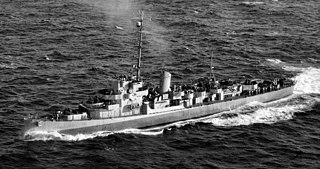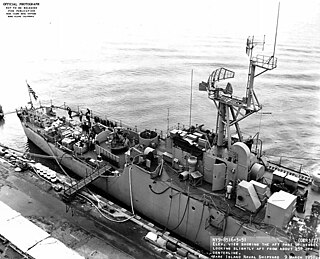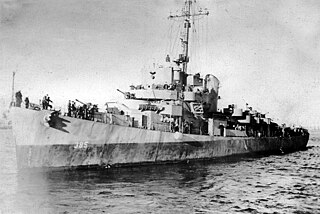USS Dallas (DD-199) was a Clemson-class destroyer in the United States Navy during World War II. She was the second ship named for Captain Alexander J. Dallas, and was later renamed Alexander Dallas.

USS Simpson (DD-221/APD-27/AG-97) was a Clemson-class destroyer in the United States Navy during World War II. She was the first ship named for Rear Admiral Edward Simpson.

USS Kearny (DD-432), a Gleaves-class destroyer, was a United States Navy warship during World War II. She was noted for being torpedoed by a German U-boat in October 1941, before the U.S. had entered the war. She survived that attack, and later served in North Africa and the Mediterranean.

USS Ahrens (DE-575), a Buckley-class destroyer escort of the United States Navy, was named in honor of Private Edward H. Ahrens (1919–1942), who was killed during the Battle of Tulagi and Gavutu–Tanambogo on 8 August 1942. He was posthumously awarded a Navy Cross.

USS Burrows (DE-105) was a Cannon-class destroyer escort built for the U.S. Navy during World War II. She served in both the Atlantic Ocean and the Pacific Ocean, and provided escort service against submarine and air attack for Navy vessels and convoys.

USS Gustafson (DE-182) was a Cannon-class destroyer escort in service with the United States Navy from 1943 to 1946. In 1950, she was transferred to the Royal Netherlands Navy where she served as Hr.Ms. Van Ewijck (F808) until 1967. She was scrapped in 1968.

USS Rinehart (DE-196) was a Cannon-class destroyer escort built for the United States Navy during World War II. She served in the Atlantic Ocean and Pacific Ocean and provided escort service against submarine and air attack for Navy vessels and convoys. The ship entered the reserves after the end of the war, and in 1950 was transferred to the Royal Netherlands Navy, where she served under the name De Bitter until 1967. She was sold for scrap in 1968.

USS Cates (DE-763) was a Cannon-class destroyer escort built for the United States Navy during World War II. She served in the Atlantic Ocean and the Pacific Ocean and provided escort service against submarine and air attack for Navy vessels and convoys.

USS J.R.Y. Blakely (DE-140) was an Edsall-class destroyer escort in service with the United States Navy from 1943 to 1946. She was scrapped in 1973.

USS Sturtevant (DE-239) was an Edsall class destroyer escort in service with the United States Navy from 1943 to 1946 and from 1951 to 1960. She was scrapped in 1973.

USS Otterstetter (DE-244) was an Edsall-class destroyer escort built for the U.S. Navy during World War II. She served in the Atlantic Ocean the Pacific Ocean and provided destroyer escort protection against submarine and air attack for Navy vessels and convoys.

USS Snowden (DE-246) was an Edsall-class destroyer escort built for the U.S. Navy during World War II. She served in the Atlantic Ocean the Pacific Ocean and provided destroyer escort protection against submarine and air attack for Navy vessels and convoys.

USS Howard D. Crow (DE-252) was an Edsall-class destroyer escort built for the U.S. Navy during World War II. She served in the Atlantic Ocean the Pacific Ocean and provided destroyer escort protection against submarine and air attack for Navy vessels and convoys.

USS Sellstrom (DE-255) was an Edsall-class destroyer escort built for the U.S. Navy during World War II. She served in the Atlantic Ocean the Pacific Ocean and provided destroyer escort protection against submarine and air attack for Navy vessels and convoys.

USS Harveson (DE-316) was an Edsall-class destroyer escort built for the U.S. Navy during World War II. She served in the Atlantic Ocean the Pacific Ocean and provided destroyer escort protection against submarine and air attack for Navy vessels and convoys.

USS Joyce (DE-317) was originally commissioned as a US Coast Guard Edsall-class destroyer escort built for the U.S. Navy during World War II. She served in the Atlantic Ocean and the Pacific Ocean and provided destroyer escort protection against submarine and air attack for Navy vessels and convoys. During its World War II service, on two different engagements with enemy submarines, the Joyce rescued survivors of the tanker SS Pan- Pennsylvania and its sister ship USS Leopold. Joyce received one battle star for its service during World War II.

USS Roy O. Hale (DE-336) was an Edsall-class destroyer escort in service with the United States Navy from 1944 to 1946 and from 1957 to 1963. She was scrapped in 1975.

USS Richey (DE-385) was an Edsall-class destroyer escort built for the U.S. Navy during World War II. She served in the Atlantic Ocean and the Pacific Ocean and provided destroyer escort protection against submarine and air attack for Navy vessels and convoys.
USS Johnnie Hutchins (DE-360) was a John C. Butler-class destroyer escort acquired by the U.S. Navy during World War II. The primary purpose of the destroyer escort was to escort and protect ships in convoy, in addition to other tasks as assigned, such as patrol or radar picket. She served in the Pacific Ocean, and, post-war, she returned home with a Navy Unit Commendation awarded to her for her battle with Japanese midget submarines on 9 August 1945.

USS Greenwood (DE-679) was a Buckley-class destroyer escort in service with the United States Navy from 1943 to 1962. She was scrapped in 1968.


















